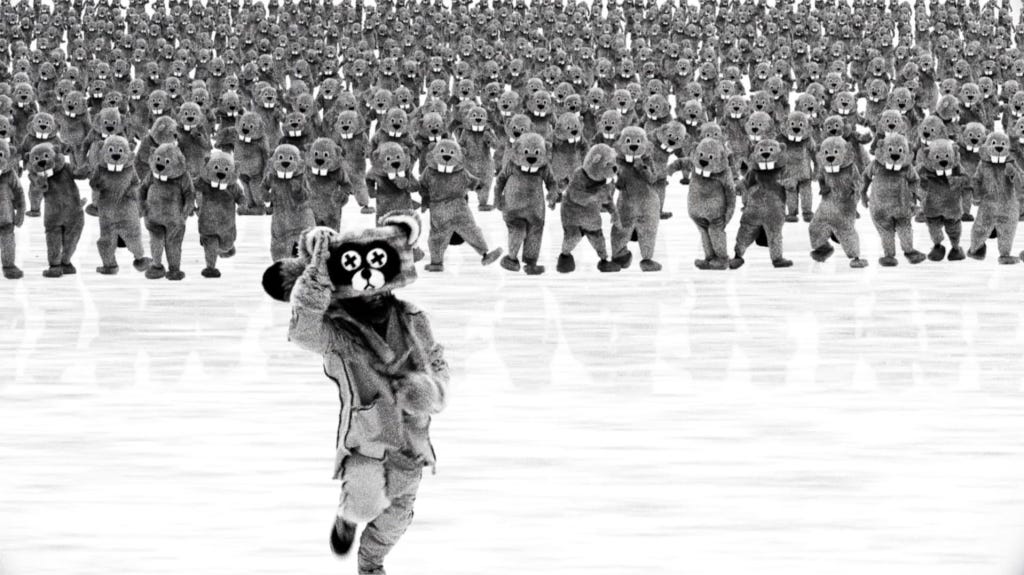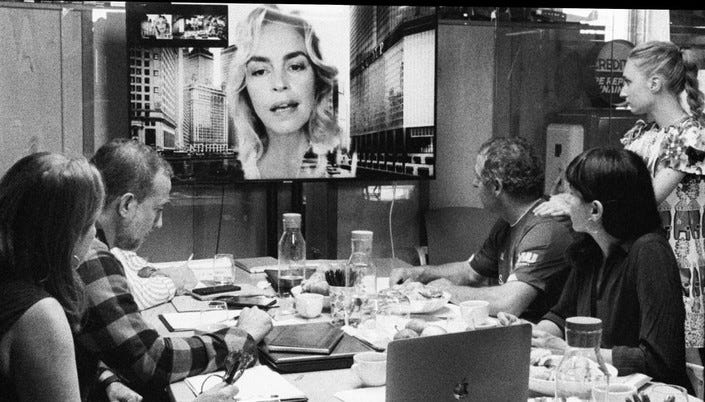You can do anything
As long as it's funny/interesting
I went to the theater last weekend to see a rep screening of Monty Python and the Search for the Holy Grail for the movie's 50th anniversary. It's a movie I must have seen 100 times, but had never before seen in a theater with a crowd and I was really struck watching it this go round by how some of the younger people in the audience reacted to elements of the film that I now take for granted but are on first-viewing shocking, form-breaking, anarcho-socialist departures from what "film" usually looks like.
It was a really nice reminder of my core belief about film, which is...
YOU CAN DO ANYTHING
If you know the movie (or the Monty Python crew in general) you are probably familiar with some of the insane swerves the film takes -- handdrawn animation, replacing horses with people knocking coconuts together, a sudden shift to present day police officers trying to solve the brutal murder of “A Famous Historian” at the hands of a sword-wielding knight.
I’ve written on my beliefs about rules here before, but I really do think that “Screenwriting Rules” are more than anything an attempt to minimize getting in trouble. In a field as cutthroat as Hollywood, it feels safe to play it safe, because you definitely don’t want to accidentally do anything super embarrassing like make the wrong decision and look stupid. Whether you’re a writer, a director, an actor, or on the studio side of things — there is nothing worse than taking a big swing and everyone seeing you miss. Well almost nothing worse… the worse thing would be making something boring. And predictable. And by the numbers. Something that follows all the rules and is still not very interesting.
The most exciting moments at the movies, the things that cause twelve year olds in the audience to gasp, tend to be the things that take us by surprise.
That can be a sequence with a bunny that brutally slays a bunch of armor-wearing knights until it is blown up by a Holy Hand Grenade, or… that can be something much broader, like the entire conceit of your film.
HUNDREDS OF BEAVERS
Let’s leave Holy Grail in the past. After all, it’s a famously inexpensive independent film made by a comedy troupe in Britain in the 70’s. Is it the best reference for what “works” in filmmaking? Well how about we look at a wordless silent film entirely shot in black and white released… last year?
Hundreds of Beavers (an even more DIY effort than Holy Grail) is, according to Variety, “a DIY delight, reinventing silent comedy on its own antic terms.” It’s one of those “you kinda just have to go see it” movies. Part Buster Keaton slapstick, part Super Mario Bros inspired video game adventure, part black & white acid trip… Hundreds of Beavers follows virtually none of the rules. Nothing about this idea is commercial, or even really advisable. Partly this is out of necessity. The film cost around $150K to make. But necessity breeds innovation.
And truly innovative filmmaking (and distribution) tend to have a lasting impact.
The film has gone on to earn over $1M in box office with a grassroots campaign of screenings across the country, many of which feature… you guessed it… giant beavers in attendance.
What’s the point you’re making here Colby? Of course funny movies can break the rules. That’s what makes them funny.
Well what about horror?
BARBARIAN
Spoiler alert. If you don’t want to a fun moment from 2022’s Barbarian spoiled for you… skip ahead to the next bold section.
Barbarian has one of the most shocking smash cuts I’ve seen in recent memory. And it’s not a scary one at all. After a full hour of horror we quite suddenly are transported to Justin Long’s convertible cruising along the PCH singing along with the radio. It’s hilarious. And shocking. And most of all, an extremely interesting narrative choice. Enter a new protagonist at… the midpoint?
It is not what you are supposed to do. But it’s what Zach Cregger has chosen to do, and it’s a moment that makes your audience lean all the way in. What in the hell is this movie going to be now? It’s a creative decision that takes supreme confidence, and I would contend is a big part of what made the movie both a hit with audiences and landed Cregger on just about every “director wishlist” in Hollywood. It’s a gutsy, surprising… “You can do anything” kind of story decision. And one that works.
If you are trying to entertain, there’s nothing better you can do than surprise us! We’ve seen a lot of movies play by the rules, not nearly as many that break them. And if you can come up with an interesting way to break the rules, that’s the kind of movie people return to, and continue to think about for a very long time.
Which brings me to two movies I’ve seen recently that I can’t stop thinking about.
DO NOT EXPECT TOO MUCH FROM THE END OF THE WORLD
Radu Jude’s 2023 comedy/drama (available on Mubi, who really have been doing the good work of curating innovative movies) has a 2hr 43min runtime. It is in both color and black and white. It features a lot of TikTok. And video conferences. It’s about a casting PA who desperately needs a few hours of sleep working on a safety video produced for a multinational corporation. It’s funny… yes, but also… something else entirely. I have not seen a movie like it. Ever. And I’ve defintely not seen a better depiction of what contemporary life feels like right now. If you haven’t seen it, do yourself a favor.
One last recent example, and one that nobody could argue is a comedy…
WARFARE
Alex Garland & Ray Mendoza co-directed this film entirely based off the reconstructed memories of Mendoza’s Navy Seal Platoon. The film has no traditional narrative structure, no traditional protagonists or antagonists, no traditional character arcs, and in listening to Garland and Mendoza discuss it in interviews… nothing was incorporated in the film if they could not corroborate someone’s memory with another member of the platoon’s who was also there that day.
The film is disorienting. And strange. And I would argue pushes the idea of documentary theater to its absolute limit in the construction of this practically experimental war film. This one is deceptive because it feels from the marketing like it might be like a lot of other movies, but having seen it, there’s nothing else like this that I’ve ever seen. And while I wouldn’t say I “enjoyed” it, I would say I haven’t been able to stop thinking about it.
I’d highly recommend listening to Garland & Mendoza discuss the film. They appeared recently on The Big Picture and Garland specifically says one of their goals was “complete artistic freedom,” which necessitated doing the film at a certain scale, ie, for not that much money.
DO NOT FOLLOW THE RULES, FOLLOW THE FILM
So yes, I’m brining up indie comedies and non-conventional war pictures. But that’s the point. Artistic freedom is possible, it just comes at a certain price point. And with artistic freedom comes the ability to do anything. The artists that people are especially excited about right now… Jane Schoenbrun, the Safdies (let’s say Nathan Fielder too, why not!), Celine Song, Chloe Zhao, Yorgos Lanthimos… all are exactly where they are because they chose to MAKE INTERESTING FILMS. And doing something interesting is often in direct conflict with… following conventional wisdom.
The real secret to making a movie successful is doing everything you can to follow the film itself. It is a waste of time to worry about what needs to happen in a movie. All that matters is what needs to happen in this movie.
As long as the movie you are making is interesting, you’re doing it right. “We come to this place for magic,” as Nicole Kidman famously says 55 times a day at any AMC theater in the world.
The only rule I’d recommend following? Show us magic.
Hollyweird in the news!
Speaking of new and innovative, IndieWire has launched a new vertical to their site all about “The Future of Filmmaking.” A) I think it’s a great new addition to an already really great site, and B) their newsletter “In Development” was nice enough to feature Hollyweird and my recent piece about learning to tolerate disappointment.












Love the inclusion of 'Barbarian' here, this 'midpoint moment' is really jarring but it works so well. It also introduced me to the great Donovan song, 'Riki Tiki Tavi,' a great song I'd never heard of until seeing this movie.
Colby, hyper-specific Substack question for you: how do you generate main page thumbnails (with the wraparound peach "Hollyweird" frame) that don't necessarily appear as images in the posts themselves?
(Also, while I'm here -- love the 'Stack. Fellow screenwriter who sincerely appreciates your industry wisdom and non-didactic perspective!)